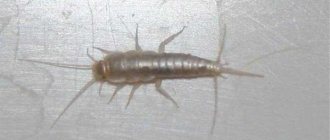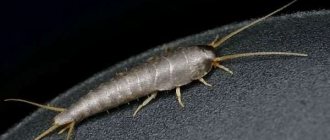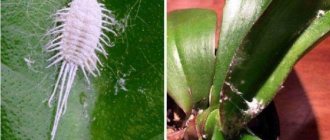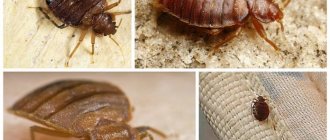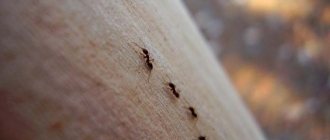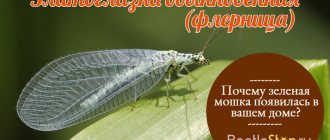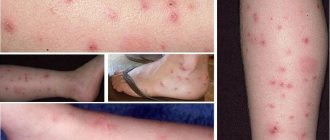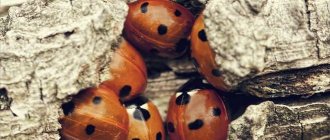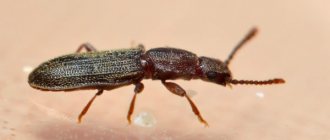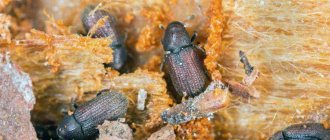Insects in the apartment
The appearance of small white bugs in an apartment will surprise the most experienced homeowner. Among the many types of insects, there are several similar ones, which may turn out to be white, beige or transparent.
Below are photos and names of white insects in an apartment or house:
- silverfish - small bugs up to 1 cm long, having a white, light gray or translucent, elongated body ending in 3 hairs; they are active only at night and can move quickly;
- woodlice - gray, gray-white or brown individuals, the body of which is divided into segments, each of which has a pair of legs, belong to the type of land crustaceans, breathe with gills - such insects are found in the house from dampness and their main diet consists of plant debris and water;
- mosquitoes and larvae - prefer to rest during the day in a room with high humidity;
- sewer beetle - distinguished by its gray-black color and large size (up to 3 cm), a strong shell that protects it from being crushed, very agile and fast, prefers warm and damp places;
- spiders, midges, centipedes or ants - are able to penetrate from the basement or neighboring apartment through ventilation pipes;
- small black bugs in the bathroom, called beetles or flour beetles, feed on cereals and bulk foods.
Insects in the apartment and bathroom
Woodlice
These insects have an oval body of light gray, white, beige or brown, convex on top, and consists of several segments. The bug has 7 pairs of legs and a hard shell, and in front there are antennae up to half the length of the body. In nature, woodlice love damp places, which is where they got their name, but sometimes they settle near human habitation. They can climb into the cellar and into some rooms in the house (bathroom or toilet) where there is high humidity.
You can see such insects in the toilet or bathroom only when you turn on the light at night, because during the day they hide in secluded corners. Woodlice feed on plant debris and can harm plants in the garden. Inside residential premises, they can live not only in the bathroom and toilet, but also in living rooms where there are decorative flowers in pots. Here they find not only water, but also food.
Penetrating into living spaces, woodlice can not only frighten people who are disgusted by insects that run quickly, but due to moisture and mold they become carriers of various fungal diseases, which pose a danger to human health.
Therefore, it is imperative to combat such moisture-loving insects, taking all possible measures to destroy them.
Cleaning the premises
Adults and larvae are removed by tidying up the space using a vacuum cleaner. The dust louse cannot stand cleanliness and fresh air. The floor is washed with the addition of ammonia, vinegar or soap base. Adult beetles are more susceptible to odors than larvae.
Small items are taken out into the cold or placed in the freezer
After washing items in hot water, iron them with steam, focusing on folds and seams
Insects are almost invisible in the house, which increases the difficulties associated with their destruction. Young larvae sense poisons most acutely. The best time for events is from May to October. Disinsection of a home consists of the use of the following drugs:
- Phoxide;
- Diphos;
- Supronit;
- Mittox;
- Morimol.
The products are based on contact insecticides. If a bug or black caterpillar or worm gets on the body cover, they are paralyzed and subsequently die. The procedure requires personal protective measures using rubber gloves, a respirator or a respiratory mask. A suit with long sleeves and trousers wouldn't go amiss.
What are the types of such beetles?
Before you begin work on exterminating this insect, you need to clearly know what type of beetles appeared. This will help you get rid of it most effectively.
Perhaps a grinder appeared. This is a beetle that feeds exclusively on wood products. His favorite is old furniture. It can also feed on old books; over a certain period of time, it grinds the pages to a flour-like state and lays eggs there. After that, this is the habitat of the larvae of the borer. And they are precisely omnivores.
The flour beetle is also not the rarest guest in the kitchen. It mainly occurs in flour and cereals. The size of such a beetle can reach only 2-4 mm. The color range varies from dark yellow to brown. Mucoeds are much smaller in size and are not picky about food. In addition to flour and cereals, they also feed on wooden furniture and books.
In addition to these two types of beetles, carpet beetles can also appear. This variety is not distinguished by its harmlessness. It can really harm both the entire home and human health. The carpet beetle is known in various forms, but not everyone can get along in an apartment. The main inhabitants of the apartments are the following:
- ham. The body is black, the antennae are yellow. Oblong in shape. The most common type;
- carpet The larvae of this insect are mainly dangerous. The beetles are brown in color. Feeds mainly on dust. Adult beetles do not feed at all, as they have a huge supply of nutrients;
- The fur coat beetle is the most harmful beetle compared to the rest. The color is black spotted. Uses food as food;
- Kozheed Smirnova. The diameter of the beetle reaches 3 mm. Coloring page brown. Lives mainly on lamps and window sills.
Such an insect can appear at any time of the year. The place for them to enter a living space can be either an open window or ventilation holes. Some species disappear with cold weather, while others, on the contrary, live throughout the year.
First of all, you need to look for bugs in open bags of cereals. It is thanks to the open space that it is easiest for beetles to climb. If there are a lot of beetles in such a bag, then you need to take active action, because they have already penetrated into closed containers with cereals. The hole that such a beetle gnaws is very small and is not visible to the human eye.
It is necessary to inspect the entire food supply; beetles can infest not only cereals, but also sugar, pasta, and flour.
There will be no such insects in salt; they have a negative attitude towards it.
The ideal location for beetles is beans. This is a favorite delicacy of such pests. Beans are best stored in the freezer. If this is not possible, then even a closed bag and container will still get a beetle.
It is not uncommon for beans to harbor a special type of beetle. Do not forget that the larvae of such beetles have been in beans before, they just remain dormant for a long time. As soon as the beans are transferred to a warm room, the larvae turn into full-fledged beetles, after which holes and spots appear on the beans. Therefore, to prevent pests, beans must be kept in the freezer.
Attention should also be paid to medicines and spices. Beetles love mustard plasters very much, even despite their bitter taste. Therefore, it is also necessary to check the mustard plasters. The packaging with patches and tablets also deserves special attention. You need to thoroughly check the entire medicine cabinet. It happens that if you put things in order, the beetles themselves crawl out into a visible place. Spices and seasonings can also harbor pests.
Coffee, dried fruits, and tea also do not go unnoticed by beetles. Housewives constantly forget about these products. And if a brown beetle gets into a coffee can, it will be very difficult to find them. If you make a drink, then such beetles will emerge. And the sight is very creepy. Therefore, it is simply necessary to monitor such containers.
White insects in the apartment - find out who it could be
- Cockroach larvae. White insects in the apartment may turn out to be newborn cockroach larvae. They are completely white, do not yet have wings, and can be recognized due to their morphological similarity to their “parents.” Within a few hours after ripening from the ooteca, they acquire a dark color.
- Woodlouse. Woodlice has an oblong body and many legs. Its color is silver, but in the sun it appears transparent. These crustaceans love humidity, so they settle mainly in the bathroom, in the kitchen under the sink.
Description of pests
Small white bugs that often appear in apartments can come in many different varieties.
- So, it could be silverfish. These are small transparent, translucent or white-gray insects that have a long body with 2 mustaches on the head. These insects are active at night; their main feature is the ability to move quickly. They can often be found in flower pots. Having settled there, they begin to eat the foliage of domestic plants. In addition, they feed on everything that contains starch, polysaccharides and protein.
- Another type of bug that you may encounter at home is woodlice. This insect belongs to a type of land crustacean. It has antennae, gray-white, gray or brown in color, and its body is divided into separate parts, each of which has its own pair of legs. This living creature lives mainly in damp conditions, becoming more active at night in order to find food for itself. They eat mainly decaying organic matter, which is of plant origin.
- Butterflies are another white bug that can be found while living in an apartment. This is a small insect measuring up to 4 millimeters in length; to many it resembles small moths. These microscopic insects love dampness and lay their larvae in places that are characterized by dampness and dirt. As for nutrition, they eat organic remains.
Such insects live mainly in bathrooms and other places characterized by high humidity and dampness. In general, insects are completely harmless in small numbers. They are not carriers of the disease and do not harm either humans or pets. However, with a sharp increase in the number of insects, they can harm household items or plants.
Thus, a large number of silverfish can harm books or wallpaper, as well as leave waste products on food, which is unpleasant. And woodlice can easily get into a flower pot, provided that the plant in it is regularly and abundantly watered.
In the future, the flower will quickly die, as the insect will eat its leaves and harm the roots.
Types of bed insects
Let's take a closer look at the most common types of bed insects, why they are dangerous, and how to recognize and prevent their occurrence.
Bed bugs
Blood-sucking bugs
- the most famous representatives of bed insects. Their bites cause great discomfort to humans. In apartments and houses, nesting parasites of the lurking type are more common.
Characteristic signs of bed bugs:
- lack of wings;
- white cup-shaped eggs;
- a flattened body, which, after being saturated with blood, swells and becomes round.
Bed bugs come out to hunt at night. Nests of blood-sucking parasites are not necessarily located in the wooden joints of the bed and the folds of upholstered furniture. They often hide in closets, under baseboards, and on the backs of carpets. To build nests, bedbugs choose dark, hard-to-reach places.
Bed insects practically do not carry pathogens of dangerous diseases, but the possibility of infection cannot be completely excluded. Blood-sucking bedbugs are potential spreaders of Chagas disease, hepatitis B and trypanosomiasis. In the body of bed bugs, the causative agents of Q fever and tularemia can remain pathogenic for a long time.
Fleas
Fleas
– insects without wings with a piercing-sucking type of mouthparts. All adults feed on the host's blood. The latter is represented by different species of animals or people. For example, if an individual fed on the blood of a rat that died, the flea will easily change its owner to a mouse, dog, cat or other animal. It is possible that the parasite will decide to feast on human blood.
The main morphological characteristics of fleas:
- small body size - from 0.5 to 5 mm;
- brown chitinous cover of light or dark shade;
- body shape – oblong, flattened on the sides;
- one pair of simple eyes, some species lack them.
On the smooth chitinous cover, you can see bristles and jagged projections that help the flea move inside the feathers and fur of the host. The structure of the parasites' oral apparatus is maximally adapted for quickly piercing the skin and absorbing blood directly from the capillaries.
A few words should be said about flea larvae.
They resemble small white worms without limbs, 2-3 mm long.
There are sparse hairs on the surface of the body, but they can only be seen under a microscope or magnifying glass. The flea larva differs from the fly larva (maggots) in having more transparent body coverings. Ectoparasites penetrate into human homes along with rats, mice and other synanthropic rodents. In a similar way, they can get into a private cottage, into the attic, into the basement and into the garbage chute of multi-apartment city buildings.
Why are fleas dangerous? They carry pathogens of dangerous infectious diseases:
- Plague
. The causative agent of the disease is Enterobacteriaceae. It is carried by 120 species of fleas. They infect the host by defecating on the affected skin, and enterobacteriaceae enter the bloodstream through bite wounds. - Marseilles fever
. The pathogens remain viable for up to 44 days. - Typhus
. The causative agent of the disease is Muser's rickettsia. Mortality is less than 0.6%. The main carrier is fleas that feed on the blood of mice and rats. The main route of human infection is rubbing waste products of ectoparasites into scratches. - Tularemia
. Fleas are capable of storing pathogens in their bodies for up to 150 days. - Other diseases
: tsutsugamushi fever, erysipeliodiasis, brucellosis, Q fever, pseudotuberculosis, tick-borne encephalitis, meliodosis.
If the previous owner of the fleas dies, they immediately leave the corpse and go looking for a new source of food. This contributes to the rapid spread of infectious diseases among animals and people.
Lice
Lice
- permanent parasites of animals and humans. They feed on the blood of the same species all their lives. Human parasites include body louse, head louse and pubic louse.
The main morphological characteristics of lice:
- small insects up to 4 mm long;
- a flattened body that tapers towards the anterior end;
- oral apparatus of piercing-sucking type;
- nits (eggs) oval-elongated;
- egg length is less than 1 mm.
The body louse deposits nits in the folds of bedding and on human clothing. For nutrition, it temporarily transfers to the host’s body.
Ectoparasite bites lead to the appearance of pediculosis. Lice are specific carriers of the pathogens of louse-borne and relapsing typhus, and 5-day Volyn fever. Human infection occurs when waste products of blood-sucking insects enter damaged skin, as well as when ectoparasites are crushed.
Insect habitats
Absolutely all insects cannot do without water, therefore, when they get into an apartment, they look for rooms and places in them located closer to sources of moisture:
- pipes (water supply and sewerage) on which condensate accumulates;
- hard-to-reach and well-hidden areas in the bathroom, near communications;
- wet or damp rugs on the floor, various hygiene products with moisture residues;
- places where dust accumulates and is not removed (the floor under the bathroom, the backs of shelves in a cabinet, etc.).
On a note!
The appearance of white or gray bugs in the bathroom is most often caused by poor sanitary conditions in the room. In addition, some insects may come from neighbors after baiting has been carried out in their apartment. Some exceptionally tenacious specimens then migrate in search of a new home.
Why do bugs appear in the kitchen?
First of all, you need to understand that if you have food in your kitchen, then bugs can appear in any case, no matter how hard you try to maintain order.
Cereals receive bugs while still in the warehouse.
There may be several sources of infection:
- The most common way bugs appear in the kitchen is from the grocery store. Do not be surprised. Even a hermetically sealed bag of cereal can contain parasite larvae and adults. They can get into cereals and groceries both directly during sorting and already in the store if storage conditions are violated.
- From neighbors through ventilation. If your neighbors turn a blind eye to the problem, sooner or later strike squads of bugs will make their way to you through the ventilation. Since they reproduce very quickly, their presence will soon become noticeable.
- Some parasites can be found in textiles or wooden products. Therefore, we recommend that you wash towels or oven mitts well, and put wooden utensils in the freezer for a couple of hours.
Note! Even one spotted bug is a reason to be wary and take treatment and prevention measures. Therefore, carefully monitor the condition of your kitchen and do not neglect processing cereals after purchasing them.
In addition, many bugs love animal food, so it is better to put it in the pantry or refrigerator.
Invasion of woodlice in apartments (video)
- Sugar silverfish. White insects in the apartment may be sugar silverfish in the very early stages of their development. They live in drawers in the kitchen, food warehouses, and books, as they love to feed on the glue of bookbindings. But it can live in any dark, damp place. It is difficult to detect them, since they come to the surface mainly at night. However, if there are a lot of them, then you can notice them during the day; a young silverfish looks like a long white insect in an apartment.
- Whitefly. On indoor plants you can find small white midges - these are whiteflies. They appear literally for no reason, but getting rid of midges is easy, just spray the leaves and soil with a weak solution of potassium permanganate. Few people know that this is a whitefly; most often these arthropods are perceived simply as white flying insects in the apartment.
- Food midges. Light-colored bugs in products can be midges, which feed on any bulk products. They all look the same, and despite the fact that some may describe them in more precise terms, most people perceive them simply as small white insects in the apartment. Midges multiply very quickly, and after a while they can be found in seemingly hermetically sealed products. Drosophila midges - or, scientifically speaking, fruit flies - appear due to high humidity, due to the presence of garbage and crumbs, rotting food, etc. in the kitchen.
- Bedbugs. The white species is not as common in homes as regular bed bugs. They bite people less often and live most often in attics and eaves, as they attach themselves to bats and feed on their blood.
- Moth larvae. Moth larvae, both food moth and clothes moth, look like small white caterpillars and are practically indistinguishable from each other. Of course, the larva is unlikely to look like an adult insect to anyone, so moths can only be included in this list conditionally, only as something that is white in color.
Small white insects in an apartment can be anyone; sometimes it is very difficult for a non-specialist to identify them. In this case, in the fight against them it is necessary to use drugs with complex effects.
Preventing the appearance of small midges and bugs in the apartment
It is much easier to prevent the appearance of small parasites in a residential building than to eliminate colonies that have appeared on a massive scale.
- Firstly, avoid the accumulation of dust and dirt in the room, since small bugs most often appear in dusty places. To protect furniture from pests when wiping dust, you can use a polish; this product has a double effect - it removes dirt and repels insects with a specific smell;
- secondly, monitor the condition of pipes and risers in the apartment, eliminate condensation on windows and glass-ceramic surfaces, it is moisture that attracts woodlice and other types of silverfish;
- thirdly, periodically thoroughly ventilate the room, in this way you will saturate your living area with oxygen and help eliminate all egg clutches of insects laid by this time, since pests cannot tolerate cold;
- fourthly, to protect your apartment from the invasion of small pests, it is worth using such harmless products as soda, laundry soap, lemon when cleaning the premises - these components do not have a negative effect on humans, but they do an excellent job of controlling insects;
- fifthly, the use of herbs is considered an excellent means of preventing the appearance of insects in kitchen and wardrobes, as well as among books. Rosemary, lavender, walnut, eucalyptus have a pleasant smell for humans, but many insects cannot tolerate this aroma. You can use dry bunches of herbal mixtures, laying them out on shelves and under tables; for the same purpose, it is permissible to lay out unpeeled garlic cloves in kitchen drawers.
By taking precautions, you will not encounter the problem of removing insects from your apartment, so you should not neglect them, especially since all the proposed remedies are very simple and accessible to everyone without exception.
Whitening with lemon juice
Lemon juice will help remove grease and sweat stains and refresh the color of your clothes. This product also has a delightful fresh aroma...
YOU WILL NEED
- 250 ml fresh lemon juice
- 2 liters of water
APPLICATION
- Boil water, add lemon juice to it.
- Cool the lemon solution to a temperature suitable for washing delicate fabrics. Soak things for 2 hours in it.
- After 2 hours, remove the items from the solution and treat the problem areas with lemon juice again. Machine wash the item as usual using powder.
APPLICATION
Methods for controlling white insects
Silverfish do not bite or attack humans. However, their presence in the house makes a person wary. To get rid of this type of insect, you need to take a number of intensive measures.
- First you need to check the exhaust system in the bathroom and toilet and, if there are problems, fix them. Make sure these rooms are well ventilated. When ventilation does not work well, dampness begins to spread quickly.
- In the kitchen, you should do a more thorough cleaning, especially behind the kitchen cabinets, so as not to accumulate food for bugs.
- Bathrooms and toilets should be cleaned at least twice a week with disinfectants. This applies not only to the floors, but also to the tiles, the bathtub itself, the space under the bathtub, behind the toilet. The most important thing when cleaning is not to create dampness.
It is not at all necessary to have expensive means when fighting silverfish. As a treatment when cleaning a room, it can be: whiteness, pemolux, pomoxol and even regular soda
Mustard solution is often used, but it is important to make the solution steep. If these measures are not enough to completely get rid of beetles
It is possible to use aerosol sprays, which can be purchased at any specialty store. Such sprays include, first of all, raptor, raid, karbafos, kombat and even ordinary dichlorvos. As a rule, frequent cleaning and ventilation is enough to avoid encountering more silverfish.
What to do after getting rid of insects
After the insects are eliminated, it is necessary to carry out a complete general cleaning of the premises using detergents. There is no need to remove the grass hanging around the rooms; these odors are harmless to humans. The only thing that should not be left if there are small children at home is tansy. A child may try it out of curiosity, which will lead to poisoning.
After eliminating pests, it is necessary to carry out a complete general cleaning of the premises.
Also, preventive maintenance should be carried out every 2-3 months by treating all rooms with crayons, gels, or turning on fumigators. But with products from the store, it is advisable to be more careful. A good option would be to thoroughly freeze the purchased cereals, then unpack the packaging and dry the same buckwheat, rice or millet in the oven. Next, the cereals can be put into bags and put away for storage.
Chalk “Mashenka” will help out in this situation too
How to get rid of white insects in the bathroom
If the number of pests is small, then you can get by with simple physical home remedies for insects:
- carry out a general cleaning of the bathroom, removing dirt and condensation deposits;
- treat the entire room with bleach or other disinfectant, then apply a solution of copper sulfate;
- You can reduce indoor humidity by regular ventilation or drying using electrical appliances.
Methods for controlling insects in an apartment
Other means to get rid of small white insects:
- a trap made of a wet birch broom, which is placed in a corner at night, attracts domestic insects and parasites, they get entangled in the twigs of the broom, so in the morning you can burn it or take it away from the house;
- traps made of glass jars, wrapped on the outside with paper or tape, on such a surface any insects can easily climb up and fall down, wanting to eat the bait in the form of an apple, sugar, etc., they cannot get back along the slippery walls;
- moisten a roll of toilet paper and leave it overnight - moisture-loving bugs will rush to get into it, in the morning it must be destroyed, but not unrolled (otherwise they will run away).
Important!
If you do not kill insects, white or transparent bugs can spread throughout the apartment. Therefore, if you fail in your independent struggle, it is better to contact the sanitary and epidemiological service.
More humane ways (for pensioners)
Here we are not talking about humanity towards bugs, but about humanity towards provisions, and therefore towards pensioners. Still, if you don’t have enough money, throwing away the cereal is simply the height of madness.
Therefore, you can use this method of struggle:
- Step 1. Sift the cereal through a fine sieve and sort thoroughly.
- Step 2. Then bake it in the oven or put the bags in the freezer for 3-4 days.
- Step 3: Try to use this grain as quickly as possible.
- Step 4. Still treat the cabinets, floor and other surfaces. If you can’t use chemicals, then at least wipe it with vinegar, pour boiling water over the cracks, or you can use laundry soap (rub it and make a soap solution). You can also make a solution of boric acid.
- Step 5. Be sure to wash the dishes, as there may be larvae there.
After you put the grains back in the box, you can place “traps” there. Pour sunflower oil into the caps and the remaining bugs will certainly taste this treat. And they will drown in it, and you will simply fly out this oil and that’s it.
Then, you can place bay leaves and garlic in the cabinets. We don’t guarantee that this is very effective and will help remove the bugs forever, but it calms the soul.
Mosquitoes
In the summer there is nowhere to hide from mosquitoes. As a rule, they enter the bathroom through an open window or through ventilation pipes. However, if you live on the ground floor and there is a basement below you, then mosquitoes may well seep into your apartment through cracks in the floor. The fact is that mosquitoes prefer damp and dark rooms, which means the bathroom is an ideal place for them. Getting rid of mosquitoes is quite simple.
Prevention measures
- To avoid the appearance of bugs in the apartment, it is necessary to ventilate the room as often as possible, especially kitchen cabinets.
- It would be a good idea to wipe them from the inside with a cloth soaked in vinegar.
- When buying cereals and pasta, you need to look at the packages with their contents, as they may already contain pests.
- When purchasing furniture, you should also inspect it for the presence of characteristic holes.
- It is advisable to treat all wooden materials that are used to decorate the apartment with an antiseptic (Antizhuk, Wood Healer).
- To prevent bugs such as springtails from appearing in your apartment, you should not over-moisten the soil in which the plants grow. In addition, it is a good idea to sprinkle some ash on top of the soil.
- Stocks of cereals can be stored on the balcony in winter to prevent beetles from infesting.
- And, of course, keep the apartment clean, vacuum furniture and carpets more often, treat them with steam, and prevent dampness in the bathrooms; Take out the trash promptly.
Invasion of small insects in new buildings
In recent years, cockroaches in residential buildings have been replaced by small insects - hay beetles. Oddly enough, this problem is especially relevant for new buildings. Hay eaters are tiny insects whose natural habitat is in the wild. They settle under the bark of trees, in the forest floor, and on dead wood. But now they can be found in residential areas. Hay beetles especially often attack new buildings.
There are several reasons for this. Firstly, there are no natural enemies of these insects in new buildings, and they can be easily brought in from the natural environment.
Secondly, hay eaters love stagnant moisture. In modern construction, there are mistakes that lead to the accumulation of moisture in the seams between panels and floors. Small insects are attracted to under-dried casein glue, wet plaster, and grout. Stagnant moisture is an excellent environment for the development of small insects. In search of food, insects penetrate the smallest cracks, and then multiply and spread throughout the apartment. In new buildings, hay eaters most often feed on mold.
Centipedes: nods and flycatchers. Insect repellents
Sometimes long, multi-legged, repulsive-looking creatures appear on the floor or walls in an apartment. Usually these are flycatchers or flycatchers - the closest relatives of insects belonging to the class of animals. There is no need to be afraid of them, the creatures are harmless, only in case of danger, the flycatchers emit a pungent odor, and the flycatcher can bite if you pick it up.
Animals live on moist soil, centipedes enter the room by accident or climb into the winter, stay in it for a long time and reproduce if there is moisture, and most importantly, food - cockroaches, flies, butterflies, mosquitoes and silverfish.
To combat invertebrates, physical methods of influence are used; this is enough if the individual appeared in the home by accident. When the population increases, the food source is eliminated: insects living in the apartment. Boric acid or any insecticides are also used.
The most effective ways to combat bugs in the bathroom
Next, I will tell you how these products are used and what insects they can get rid of.
The easiest way to kill insects is to use special insect repellent aerosols. The most common and well-proven types are the following:
- Raid;
- Raptor;
- Combat;
- Cobra et al.
Aerosol Raide
The price of aerosols ranges from 100-300 rubles. In terms of effectiveness, they have approximately the same effect on insects.
Aerosols are an excellent solution if there are midges in the bathroom, spiders, silverfish and other representatives of arthropods. The main thing is to use them correctly:
- The aerosol can must be shaken before use;
- then close the bathroom door;
- after that, spray the contents of the container onto places where insects accumulate and move (paths);
- to get rid of flying insects, spray the contents of the container into the air, moving from the center of the room to the door. Keep in mind that the aerosol should be sprayed at a distance of a meter from the surface of walls and furniture.
Of course, it is imperative to eliminate the causes of insects. For example, before getting rid of midges, you should remove the food debris on which they fly.
If you are worried about a spider in the bathroom, then you need to remove all the webs with a broom. Crush the individuals that you managed to spot with a slipper.
In the photo - the insecticide Karbofos Insecticides are special poisons designed to combat insects.
Moreover, initially they are focused on the destruction of garden pests. However, as practice has shown, these compounds are very effective in combating woodlice, silverfish, ants, cockroaches, etc. The following types of insecticides have proven themselves to be effective:
- Lambda Zone;
- Karbofos;
- Avalon;
- Regent;
- Fufanon-super, etc.
Insecticide regent
Since insecticides are intended to control garden plants, the instructions for use do not say anything about how to use them to kill insects in your home. Therefore, people have experimentally found that the most effective instruction in our case looks like this:
- the contents of the sachet must be dissolved in a glass of water;
- after this, the resulting solution must be drawn into a syringe;
- Next, drip the composition into places where insects most often accumulate, as well as into cracks in the floor and baseboards, if any. The only thing is that before treating surfaces with insecticide, they should be cleaned of dirt and dust.
We suggest you familiarize yourself with: Lavender oil for odor
It must be said that, according to many people, a particularly effective remedy for cockroaches is Regent, which contains fipronil. The latter has a strong neurotoxic effect on insects. In particular, it is even capable of destroying populations that have developed resistance to other types of insecticides.
Boric acid
If your bathroom is infested with ants, woodlice, millipedes or other insects, you can use the old “grandmother’s” method of fighting them using boric acid. Since this product has been tested for years, there is no doubt about its effectiveness.
Boric acid is used as follows:
- a ten-gram bag of boric acid should be diluted in a small amount of water, for example, a quarter glass will be enough;
- The solution needs to be drawn into a syringe and sprinkled with it in places where insects accumulate.
There is also a “dry” method of using boric acid, which consists of mixing it with chalk in a ratio of 1:10. This mixture, like the liquid, should be scattered in places where cockroaches, ants or other arthropods that have settled in your bathroom accumulate.
Tadpoles covered with gray shells are silverfish
If you are looking for a safe and environmentally friendly way to get rid of silverfish or wood lice in the bathroom, then the best solution is to use a solution of table salt. This method looks like this:
- 5-7 tablespoons of table salt must be dissolved in a liter of water;
- Now the salt solution needs to be sprayed in places where woodlice or silverfish may accumulate.
Salt creates a dangerous habitat for these arthropods, as a result of which they inevitably die.
The smell of wormwood repels insects
Another folk remedy for insects that has been used for centuries is the use of herbs such as wormwood and tansy. Their smell repels insects, as a result of which they try to find a more comfortable place to live.
The herb is used as follows:
- first of all, pick sprigs of wormwood or tansy and dry them, for example, on the balcony;
- then spread the dry grass wherever insects may live - under the bathroom, in the corners of the room, behind furniture, etc.
It must be said that this method is less effective than, for example, insecticides. However, it can be used as an addition to other means of combating bugs, as well as for preventive purposes.
Here, in fact, are all the most effective options for ridding the bathroom of insects that I wanted to share with you. Finally, I would like to note that to effectively destroy them, you use not only the above means, but also be sure to eliminate the reasons why “uninvited guests” appeared.
Wash surfaces after insects with white
Types of bugs
It is important to understand that depending on the type of new kitchen inhabitants you have, methods of dealing with them may vary significantly. And sometimes they are not needed at all: for example, small (less than one millimeter) white bugs that can occasionally be seen in the kitchen are ordinary wood bugs. They feed on dust from your furniture, are non-toxic and do not harm human health.
White bugs: not a very pleasant, but harmless neighborhood.
True, there is another side to this - they can serve as food for other bugs with more unpleasant behavior. Therefore, we recommend that you read the information below and try to determine who you are up against and what products you may have to throw away.
One of the most common types of bugs in the kitchen is the red flour beetle. This is a tiny parasite, up to two millimeters in length, with small, hard wings of a bright red color. By themselves, they are quite harmless: they do not eat food and do not live long. However, they multiply quickly. Their small white larvae are almost invisible in foods: flour, rice, oatmeal. Small worms actively feed on cereals, leaving waste in them and spoiling the food.
Red flour eaters feed not only on flour, but also on everything they can get their hands on.
Determine: Musty smell and holes drilled in the grains.
The mealworm is much more dangerous for humans. A brown bug up to three millimeters in size has a mustache and powerful mandibles. You can find it in stocks of flour or potato starch, but there are also not too whimsical individuals for which any crumbly product will suit.
Not only destroys food, but also harms health.
It is noteworthy that they do not strive to completely eat even their favorite flour - as soon as it begins to smell unpleasant, the entire colony migrates to the next container.
Their danger lies in the fact that the waste products of the flour beetle are dangerous to humans and can cause serious poisoning.
Determine: Products gather in lumps and acquire a damp smell.
The peculiarity of the bread grinder is its incredible gluttony. The four-millimeter bug is ready to eat any food that can be found in your kitchen cabinets: flour and pasta, cereals, beans, coffee, tea, nuts, dried fruits and even tobacco.
A small bug can drain all your supplies.
There is no particular harm from it, but a few bugs can ruin a significant amount of stock.
Determine: Usually they don’t hide much, so they are immediately visible.
It should be noted that some people prefer to classify food moths as bugs in the kitchen. This is fundamentally incorrect: moths are a completely different species and need to be dealt with using other methods. We wrote more about how to get rid of food moths in this article.
Methods for killing woodlice
Uninvited “neighbors” in the bathroom do not cause trouble, but they frighten the inhabitants of the home with their unsightly appearance. When trying to remove them, you need to know that you can get rid of woodlice yourself by following several steps:
- the toilet or bathroom must be “provided” with dry, warm air. You will have to temporarily install a fan, a heater, and keep the doors open if possible;
- Often we do not notice that pipes hidden from our view have faults or simply leak. It is necessary to carry out a thorough check and get rid of possible pockets of moisture;
- Quicklime will help get rid of woodlice. This can be done before the weekend, since you will have to place a bucket of the mixture diluted with water in the room, close the door tightly, and not open it for three days;
- There is an effective and efficient “grandmother’s” method. Mix red pepper, soda ash, tobacco. The resulting mixture is dissolved in a liter of water, sprayed on the walls, paying special attention to “problem areas.” The room should be isolated for about 7-8 hours. A time-tested and effective option. To do this, you will have to leave your home, since after treatment you will need to clean it using water with a strong concentration of chlorine. It is clear that its fumes are harmful to health, especially if you have small children;
Mix red pepper, soda ash, tobacco
- Today there are special baits and compositions that help get rid of woodlice. Their effectiveness has been tested and proven, however, according to professional exterminators, their use rather consolidates the result obtained after bullying.
Folk remedies for woodlice
Prevention of bugs
In order not to solve the problem when white insects appear in the apartment, the following preventive measures should be taken:
- regularly wipe off condensation and dust on pipes;
- Maintain cleanliness in the bathroom and toilet;
- check how well the ventilation works in service areas (toilet, bathroom, kitchen), if necessary, periodically clean the shafts;
- make cosmetic repairs by sealing all existing cracks near the baseboards, in the walls and on the floor;
- If there is a leak, the taps should be repaired immediately, avoiding the accumulation of moisture;
- dry corners that are too wet using a fan heater, because insects can lay eggs in such places, and hot air will destroy them;
- if mold appears, such areas should be thoroughly treated with chlorine and then dried;
- in the kitchen you should regularly check all cereal stocks and do not leave crumbs;
- prevent the accumulation of garbage, remove food and other waste in a timely manner.
With regular cleaning, drying and compliance with hygienic rules in service areas (bathroom, toilet and kitchen), no white insects will be able to settle in the house due to the lack of the high humidity necessary for them.
( 1 rating, average 5 out of 5 )
